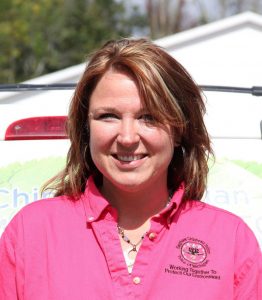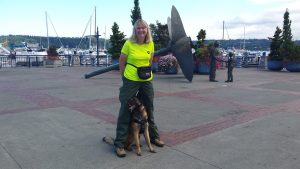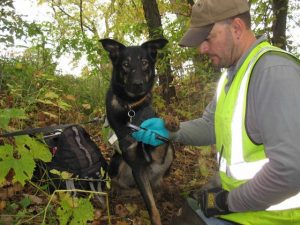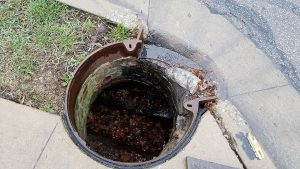
As greatlakesnow.org reported earlier this week, Lake St. Clair – the lake between Ontario and Michigan which connects Lake Huron to Lake Erie – is in trouble. And there isn’t a consensus on what’s causing the problem or how to solve it.
Detroit Free Press environmental journalist Keith Matheny says nearly a trillion gallons of partially treated storm sewer overflow has made its way into Lake St. Clair from Macomb, St. Clair, and Oakland Counties since the year 2000. The lakes best beaches are closed for weeks at a time (sometimes months) because of high levels of E. coli, an intestinal bacteria associated with human and animal feces.
Failing or illegal sewage systems and aging and broken infrastructure are one of the biggest polluters of the Great Lakes, and especially in Michigan – a state surrounded by water.
And yet Michigan is the only state in the U.S. that doesn’t have a state-wide septic code.
At a recent “State of the Bay” conference in Bay City, pollution caused by faulty septic and sewer systems was a topic of discussion on several panels.

Carey Paquette, Environmental Manager for the Saginaw Chippewa Indian Tribe, courtesy of chippewawatershedconservancy.org
Carey Paquette, Environmental Manager for the Saginaw Chippewa Indian Tribe, works on federal, state and local programs on tribal lands along Saginaw Bay. The tribe has been using progressive methods to help farmers cut back on agricultural run-off and has been trying to identify areas where there are sewage problems in lakes and streams.
The tribe has also recently begun using a new method to track down failing septic systems: human waste sniffing dogs.
Paquette says a company called Environmental Canine Services helped the Tribe discover several problem areas in the Saginaw Bay.
Great Lakes Now talked with president of Environmental Canine Services, Karen Reynolds.
She says she and her husband started the company in Lansing 8 years ago.
Reynolds says her husband Scott, a storm water professional, was working for an international engineering company and used the standard approach. “They had to go out in the field in creeks and streams and storm water drains to collect water samples to see if there’s pollution. Then you send the water samples off to a lab. Then they have to cross reference for different indicators: check for pollution in different forms, mainly human pathogens from sewage discharges.”
She says, “Sometimes it would take more than 24 hours for the bacterial samples to come back from the lab. Then they go back out in field and try to follow where they got the hits they got on those samples for the bacteria and they try to follow it upstream to find the source. “
She says, “It takes a long time. They have to wait and go back out there and go find the source with manpower.”
“I wonder if we could use dogs to detect the scent of human waste?”
She says her husband’s supervisor knew that she and her husband had an extensive background training scent dogs. And one day he said to her husband, “I wonder if we could use dogs to detect the scent of human waste right in the field and then we could immediately source- track it instead of waiting for the lab results to come back?”
Reynolds says that was the “lightbulb” moment. She says her husband Scott said “Yes we can!”

Karen Reynolds, President Environmental Canine Services, courtesy of ecsk9s.com
She says they had worked with canine search and rescue and drug detection dogs, however Reynolds says they hadn’t trained the dogs to sniff human waste before.
They got to work right away. Reynolds says, “We had some search and rescue dogs but they were getting old and we wanted a young one we could have a long working life with. We looked at animal shelters and we wanted a rescue animal to do this. “
She says the moment she and her husband saw Sable, they knew he was the dog to begin this program. “We saw him at Mackenzie’s, a no-kill shelter west of Lansing. He’s a German Shepherd-Huskie mix. First we saw a video of him online, diving in to a pond chasing after a ball. We had to have a dog who wasn’t afraid of water and who would go crazy over food or a toy. Sable had those characteristics. We had to go through a lengthy adoption process. Sable was kind of hyper! But he was perfect for us. We knew he’d work all day for the ball.”
Reynolds says they immediately adopted Sable and trained him in the detection program. They used the help of a local waste water treatment plant, using waste water and raw sewage. (Reynolds says they told her: “Take as much as you want!”)
Within 6 months, they had trained Sable to do field trials in urban and rural environments
Sable began his first human waste sniffing job in 2007.
“When he finds sewage, he barks to alert us”

Scott & Sable, courtesy of ecsk9s.com
Reynolds says, “When he finds sewage, he points to where its coming from and he barks to alert us. Each dog has a different alert. Sable likes to bark when he smells sewage. Some of our dogs sit or lay down.” Reynolds says after the dogs alert them, the (human) team maps out the area, pinpoints the problem and investigates.
She says one of the biggest cost-saving and time-saving benefits is that you don’t end up sending countless specimens to the lab to do expensive DNA tests to determine if human waste is in the water – you can pinpoint the exact spot, and send that one specimen to confirm.
Right away, Reynolds says municipalities started hiring the dogs. But soon it wasn’t just cities and counties; it was environmental and community groups who wanted to find out the sources of pollution in rivers, lakes and streams.
Reynolds says, take for example, a river: “What we do is we work the dogs upstream… until they stop barking. And then you know the source immediately. All we do is say ‘this is what our dogs found’, and then the client takes over. Sometimes the health department steps in at that point. Sometimes it’s a private company. But our job is done.”
Reynold’s company – Environmental Canine Services – officially launched in 2009. Karen Reynolds is President; her husband Scott is Vice President. They have developed three different teams across the country – in Lansing, MI; Maine, and Northern California.
Reynolds says flying is too dangerous for the dogs, so the teams that handle the dogs drive them to their destinations.
The company and its human waste sniffing dogs have responded to more than 75 jobs so far and many are repeat customers.
Humans versus cows and raccoons
Reynolds says here’s what the dogs usually uncover: “Mainly it is broken sewer lines and failing septic systems. Or when plumbers have a run a pipe from the house straight into the storm drainage system. And illicit discharges.”

Displaced storm drain cover, courtesy of dankeck
Is Reynolds seeing an improvement in sewage and septic systems these days? “No”, she tells Great Lakes Now. She says there are problems all across the country “because the sewer infrastructure in a lot of places is very old. Anything older than about 30 to 40 years – you’re going to have leaks and breaks. So that’s where we get a lot of sewer breaks. Large old cities. And the aging septic systems along lakes, rivers and creeks. Many houses are really old and residents put in septic systems and they never maintain them.”
Reynolds says here in the Great Lakes Region not only has the Saginaw Chippewa Indian Tribe used her company to detect human waste in rivers, streams and lakes, so has the Grand Traverse Conservation District, the Huron River Watershed Council, Milwaukee River Keeper and many other municipalities and environmental groups.
Sometimes, Reynolds says it’s what her dogs DON’T find that can create the biggest success.
She says in the Traverse City area, “Our dogs went there the first time and they just weren’t alerting in many places. There WAS some bacteria. But it wasn’t human. Turns out It was RACCOONs in one storm water system – we called it a ‘Raccoon Hilton!’” Reynolds says, “ It’s valuable to know the human component is NOT There sometimes because you can find out what it really is.”
Reynolds says, “Our dogs are trained to discriminate between human waste and animal sourced pathogens. So, if you’re in an agricultural area… we can find out if the cows are the ones causing the problems!”
‘Ship and Sniff’
Environmental Canine Services now has a certification program to train human waste sniffing dogs. 7 dogs currently work for the company and are considered “certified sewage detection canines.” The company has expanded to other areas as well, with a program called “Ship and Sniff” – you can send samples of the water you’re worried about to the company, they’ll have the dogs sniff it, and give you a positive or negative on human waste.
Reynolds says the need for her company’s services is greater than ever, but the good news is that she’s seeing municipalities and environmental organizations becoming pro-active these days. “They say ‘I know we’ve got a problem, so bring the dogs in and let’s clean it up”.
Reynolds says, “We feel great about it – we love the environment and we love dogs.”
The company’s original human-waste sniffing dog named Sable is still with Reynolds and her husband. He’s now 12 years old. Newer additions named Remy and Logan are on Reynold’s team now, too.
Reynolds says, “We want to have an impact on the environment.. on our surface waters. We want to have an efficient and cost-effective way for our clients to find the human pathogen sources that come from sewage and remediate it quickly…. more than the standard protocol. “
(For more information about the company, go to www.ecsk9s.com)




